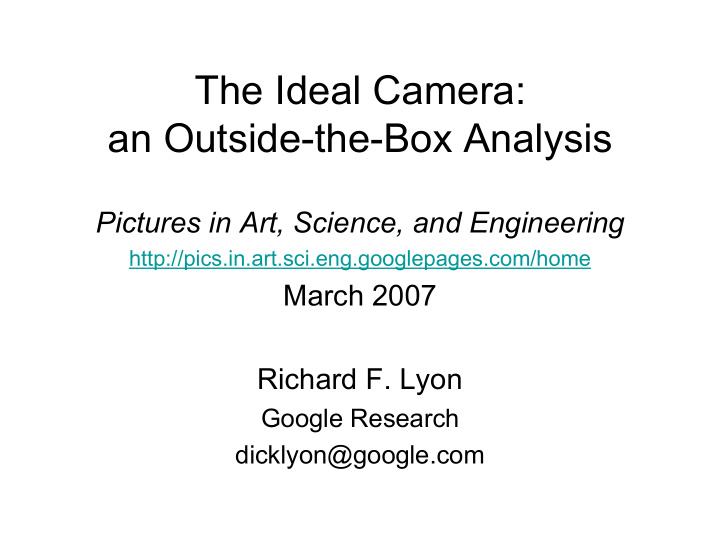



The Ideal Camera: an Outside-the-Box Analysis Pictures in Art, Science, and Engineering http://pics.in.art.sci.eng.googlepages.com/home March 2007 Richard F. Lyon Google Research dicklyon@google.com
The Super-Ideal Camera (pure fiction) • Infinite depth of field • Infinite resolution (no diffraction) • No motion blur (zero exposure time) • No noise • Zero size and weight • Needs no light • Zero cost
(Lyon’s) Three Laws of Photodynamics (rough reality) 1. Even an ideal camera needs enough light to make a good photo. 2. There’s no such thing as an ideal camera. 3. The closer you can come to the ideal camera, the better. Learn to compute how much light is needed under what circumstances, and why, and what limits the image fidelity of the ideal camera – and what non-idealities make matters worse, and how to mitigate them.
Limits to sharpness/detail/resolution • Ideal Camera • More light always – Depth-of-field helps with the tradeoff of aperture – Motion blur area, exposure time, – Diffraction blur and shot noise; but – Shot noise not diffraction • Non-idealities – Sensor resolution or film grain – Aberrations – Flare, glare, ghosting – Other noise sources
The Eye, Rays , and Waves of Light • Inverted image formation by refraction in the eye: Descartes’ La Dioptrique • Descartes’ or Snell’s Law of Sines follows from Fermat’s principle of least time • Wave explanation by Huygens’ Dioptrics and Treatise on Light (1689) • Waves and diffraction are ideal effects, in that they are based on fundamental physics of light
Light as Particles : Planck and Einstein • The ideal sensor makes a 2D histogram: counts of photons received at every location (in a plane) • Locations finely divided, compared to the diffraction-limited ideal lens response • Shot noise comes from the ideal statistical distribution of counts of independent photon absorption events: Poisson distribution
Image formation in pinhole camera obscura: too little light, too much diffraction blur camera = box
Parameterizing the Camera
Focal length doesn’t matter von Rohr, 1920 English translation: • “… we can calculate the distances … in front of and … behind the field-plane … which the object- points may attain without exceeding the radius of indistinctness conforming to the angular sharpness of vision ...” • “… At this point it will be sufficient to note that all these formulae involve quantities relating exclusively to the entrance-pupil and its position with respect to the object-point, whereas the focal length of the transforming system does not enter into them.”
Depth of field by Moritz von Rohr’s method (“outside the box”) Near and Far focus limits depend on subject distance S and aperture d S N = Sd/ ( d + C S ) = Sd/ ( d + eS ) S F = Sd/ ( d – C S ) = Sd/ ( d – eS )
Diffraction outside the box • It is standard in astronomy to compute diffraction-limited resolution from aperture diameter: resolvable angle = λ / D (ratio of wavelength of light to aperture diameter) • At subject, resolvable spacing is S • λ / D • Inside version uses f-number N for focal- plane resolvable spacing λ • N • May also use a small numeric factor, e.g. 1.22 for Rayleigh’s criterion
How much light gets in? • Proportional to aperture (input pupil) area , and to solid angle of subject being imaged • Can also express in terms of focal length, f- number, and format size (inside parameters) • F-number (1/ N 2 ) is not complete: constant f- number gives constant focal plane illuminance (photons per unit area per time), but it’s not constant per subject element if format changes; same “exposure” in a smaller camera gets fewer photons, less information, more noise
Few photons per pixel => low SNR SNR = 1.4 SNR = 0.9
Why do small cameras make noisy pictures? • Format too small? • Pixels too small? • No – aperture too small – can’t get enough photons to keep noise low – can’t make aperture big because f-number gets too low, makes it impossible to keep aberrations low
Motion Blur – outside the box • Shake: rotation rate times exposure duration gives angular blur in object field; subject blur proportional to subject distance (constant in focal plane) • Translation: speed times exposure duration gives distance of blur, same at all subject distances (inverse with distance in focal plane) • CoC limit defines a depth of motion blur
Translation blur can be treated as an extended entrance pupil
Parallax outside the box: stuttering entrance pupil • Moving your entrance pupil between shots changes your point of view, so makes it impossible to perfectly align two images into a composite • Amount of mismatch in subject field is same as the blur you get from entrance pupil size in the DOF problem; align at some distance, and compute mismatch at other distances
Recommend
More recommend